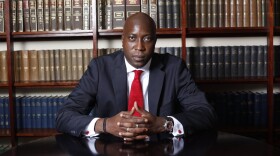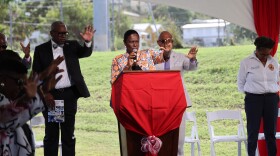ST. CROIX — As part of a grant-funded initiative of the National Park Service, two anthropology professors from California are working on a project that engages Crucians in shaping the future of The Big Island’s three national parks — Christiansted National Historic Site, Salt River Bay National Historical Park and Ecological Preserve, and Buck Island Reef National Monument.
The professors held community listening sessions this week in Frederiksted and Christiansted to gather information from residents about their experiences regarding the relationship between the community and the National Park Service.
The purpose of the project is to hear from generational Crucians about the historical use of the national park lands to help the National Park Service better understand their true significance and inform future management practices while ensuring the cultural heritage and traditions of the community are respected and preserved, according to the professors conducting the initiative.
William White III, associate professor of anthropology at the University of California, Berkeley, who serves as principal investigator for the project, said NPS must stay in compliance with the National Historic Preservation Act. He said one requirement is to evaluate and assess the significance of historic properties, including writing a narrative that explains why the properties and sites are significant.
“In the case of this project, our job is to ask folks who live on island — elders, people who are part of the traditional community, which is folks who have lived here for several generations — how they feel about different sites within the different boundaries of the national park units here,” he said.

Discussing the significance of the project, White pointed out that the informational panels on display within Christiansted National Historic Site were clearly not created by people who lived in the community. He said residents participating in the listening sessions indicated that they are not represented on those informational panels, and that the National Park Service doesn’t necessarily listen when such concerns are shared. He said the information collected from elders will be shared with NPS, noting the federal agency will no longer be able to ignore the history.
“This is part of the story of what was there, and moving forward, their programming and stuff, they’re supposed to use this kind of information to administer these sites,” he said.
White discussed the goals of the project with about 20 participants during a listening session held Wednesday evening in the conference room at Company House Hotel. A similar session took place Monday at Crucian Heritage And Nature Tourism in Frederiksted.
The contract for the project involves doing an ethnographic overview and assessment of St. Croix’s three national parks, White said, explaining that the process involves asking Crucians how they feel about the historic properties.

“Some of the historic properties in these places include archaeology sites,” he said, questioning what memories Crucians have that are associated with the properties. “The goal is to record what folks who actually live here, who have been here for generations, what these things mean to them, as well as identify additional spaces that the NPS may not know about that folks want preserved or would like some extra narrative associated with it.”
Ayana Omilade Flewellen, assistant professor of anthropology at Stanford University in California, is working on the project with White. She said they both started doing historic preservation work on island in 2017 as part of an archaeological project at The Nature Conservancy, an 18th-century sugar plantation. She spoke of the potential outcomes associated with the NPS project.

“Beyond the grant requirements, we’re really excited about how this fostering of community dialogue could also bring about other outcomes that community members want to see on St. Croix in a myriad of different ways, so part of what can be birthed in these spaces are the kind of historic preservation projects that community members want to see on island, so we’re already seeing more desire for repositories, for collections on island not just for the National Park Service but for archaeological work that’s been done across the island,” she said. “For instance, there’s a deep desire to want to have more of their celebratory spaces back in these sites as well. So many people brought up how they used to have Christmas parties down at the historic Christiansted site.”
Frandelle Gerard, CHANT executive director, is helping the professors make connections in the community to conduct the interviews necessary to collect the oral history from Crucians. She spoke of the significance of the project.

“It is the first time that residents of St. Croix are being asked to share their memories of the spaces that are now national parks, their memories of the historical uses of those spaces, and the interaction between the community and the national park system, and how that impacts their lives or their perception of spaces that are public spaces, and the use of those spaces by Crucians and residents of St. Croix,” she said.
The professors heard from participants during this week’s listening sessions regarding their perspectives on how the national park lands have shaped the identity of the community over time, the challenges and opportunities faced by the community regarding the NPS-managed lands, and what the ideal relationship looks like between the community and NPS. Participants held discussions in breakout sessions Wednesday at the Company House Hotel about their vision for the national parks, which included maintaining public access, open communication by NPS, and more opportunities for educational tours.

The professors will return to the island for three weeks in July to record interviews with elders as they continue gathering information as part of the project.
“Folks will tell us about memories they’ve had in the area and give us ideas about what was going in these places before they were a park, while they were a park, and just give us that information that’s not in photographs, or maps, or documents,” White said.

The professors will compile all the information they’ve collected for presentation in December to the National Park Service to help the agency understand the historic significance of the national park spaces to better interpret them for future generations.















